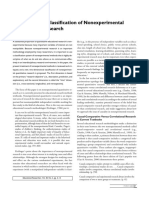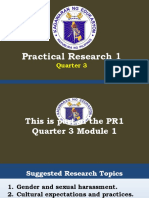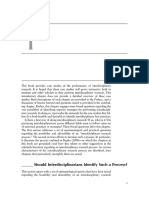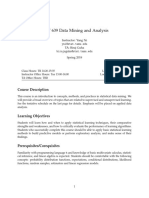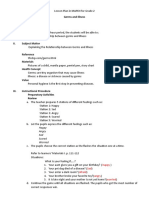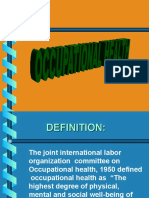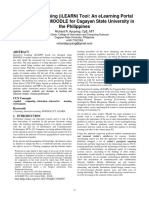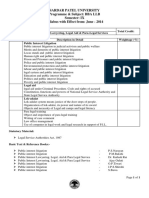Knowledge
Knowledge
Uploaded by
Thura MyoCopyright:
Available Formats
Knowledge
Knowledge
Uploaded by
Thura MyoOriginal Title
Copyright
Available Formats
Share this document
Did you find this document useful?
Is this content inappropriate?
Copyright:
Available Formats
Knowledge
Knowledge
Uploaded by
Thura MyoCopyright:
Available Formats
Vol.1 No.
2 (2018)
JALT Journal of Applied Learning & Teaching
Journ
ing
ach
al
Te
fA
g& Content Available at : http://journals.sfu.ca/jalt/index.php/jalt/index
o
ppl
ied Learnin
Mills, G. E., & Gay, L. R. (2016) Education research: Competencies for analysis and applications.
London, England: Pearson Education.
Nelson Ang Assistant Director, Curriculum and Assessment,
Kaplan Higher Education Singapore
Introduction of searching the ERIC database, fully illustrated with the
aid of screenshots, as well as, suggestions of handbooks,
Educational Research: Competencies for Analysis and go-to databases, websites, and professional organisations.
Applications was first published in 1976 as a 354-page tome However, the recommendations seem rather US-biased.
when I was barely two years old. The current 11th edition Personally I find that there is a noticeable difference in the
is testament to the book’s applicability and relevance, sensibilities of researchers from both sides of the Atlantic
successfully enduring the trial of time; key considerations pond and wonder if these recommendations will skew
within which continue to underpin educational research. The beginning researchers’ perspectives of educational research.
authors’ intention to write a how-to manual for educational
research is clearly evident. This book is the toolbox-that-
has-everything which beginning researchers would need A Potential Bias?
and very much appreciate; that the book doubled in size
over the past 40 years is neither coincidence nor accident. A case-in-point on the difference in sensibility can be found
Indeed, a significant update to the 11th edition is the revision in Chapter 10 – Experimental Research, which incidentally
of Chapter 3, Literature Review, to incorporate influences of is significantly revised “to reflect 21st Century discussions”
technology on how literature is curated. in the 11th edition (5). The general consensus in the United
Kingdom is to exercise extreme caution when setting up
experimental research to the point of avoidance. Indeed the
Literature Review: Beyond the Library British Educational Research Association (BERA) is explicit in
its charge to researchers in its published Ethical Guidelines
The review of related literature is often seen as a for Educational Research (2011):
necessary evil to be completed as fast as possible
so that one can get on with the “real research.” This
Researchers must take steps to minimise the effects of
perspective reflects a lack of understanding of the
designs that advantage or are perceived to advantage
purposes and importance of the review and a feeling of
one group of participants over others e.g. in an
uneasiness on the part of the students who are not sure
experimental or quasi-experimental study in which the
how to report the literature (107).
treatment is viewed as a desirable intervention and
which by definition is not available to the control or
comparison group respectively.
The Literature Review has constantly baffled beginning - BERA, 2011, p. 10
researchers, especially the purpose and scope of the review,
hence the choice of literature. More often than not, the
researcher loses his or her voice and erroneously takes on My own experience working with colleagues from the U.K.
the role of a reporter and merely repeats what has been said is also reflective of this position. Minimising advantage to a
(after paraphrasing of course). group of students is counterproductive in the experimental
setup because the driving motivation for doing so is precisely
The literature review begins with identifying and locating to prove that one method/intervention is advantageous
relevant documents bearing trustworthy information related over the other and “establish cause-effect relations” (286).
to the research problem. In this regard, the provision of How might one then begin to minimise the advantage
search strategies for library catalogues and the Internet that one group of students may potentially gain without
in the 11th edition is a useful companion on the search distorting the findings and yielding no results from the
adventure. It comes complete with, step-by-step guidance study? Conversely,
Journal of Applied Learning & Teaching Vol.1 No.2 (2018) 71
expounding on the design, data, and writing. If putting
In experimental research, the researcher manipulates at
together a research piece is akin to building a house,
least one independent variable, controls other relevant
Educational Research provides the how-to, templates of
variables, and observes the effect on one or more
building plans (10 in all!), tools, and even the paint for the
variables. The researcher determines who gets what;
exterior walls.
that is, the researcher has control over the selection and
assignment of groups to treatments (286).
Despite the wealth of content, it is not immediately clear
I have found too from my experience working with if students, who are about to embark on an educational
colleagues from the U.S. that randomised control trial is research journey, would be enabled to answer the most
deemed necessary for yielding valid evidence to conclude fundamental question – what good would emerge from
on the efficacy of intervention/treatment. Perhaps it is then my study? In highlighting theories, personal experiences,
not surprising that the American Educational Research previous studies that can be replicated, and library searches
Association’s (AERA) Code of Ethics (2011) is devoid of as the four main sources of research problems, it is unclear if
its British counterpart’s warning about the application of Mills and Gay are challenging their readers to put a dent in
experimental research. the educational universe or providing them with yet another
tool to progress towards that dreaded assignment deadline.
Indeed in the discussion of Ethics in Chapter 1, Mills and
Gay devoted a significant portion of the section to “Ethical Now, if only there were an app for this book.
Issues Unique to Qualitative Research” (39). In this section,
they claimed that “some features of qualitative research raise
additional issues not typically encountered in quantitative
research.” Further into the section, Mills and Gay then
charged qualitative researchers “to convey with confidence
that research participants will not suffer harm as the result
of their involvement in the research effort” (41). How might
potential harm be unique to qualitative study? References
Nevertheless, the perceived U.S.-bias aside, this is a handy American Educational Research Association. (2011). Code
book that I wish I had when I was writing up my research of ethics. Retrieved from https://c.ymcdn.com/sites/www.
plan and dissertation many eons ago. weraonline.org/resource/resmgr/a_general/aera.pdf
The Rest of the Tool-Box British Educational Research Association. (2011). Ethical
guidelines for educational research. Retrieved from https://
As mentioned earlier, this book is a well-stocked toolbox portal.solent.ac.uk/documents/academic-services/policies-
that researchers, especially beginning ones, will find useful. procedures-guidelines/bera-ethical-guidelines-for-
It begins with delineating the research process before research-degrees.pdf
Copyright: © 2020 Nelson Ang. This is an open-access article distributed under the terms of the Creative Commons Attribution
License (CC BY). The use, distribution or reproduction in other forums is permitted, provided the original author(s) and the copyright
owner(s) are credited and that the original publication in this journal is cited, in accordance with accepted academic practice. No
use, distribution or reproduction is permitted which does not comply with these terms.
Journal of Applied Learning & Teaching Vol.1 No.2 (2018) 72
You might also like
- Secondary Progression Test - Stage 7 English Paper 2 PDFDocument8 pagesSecondary Progression Test - Stage 7 English Paper 2 PDFLianie Ishak64% (28)
- Functions of The Review of Related Literature and StudiesDocument6 pagesFunctions of The Review of Related Literature and Studiesea6z9033No ratings yet
- Spider GroupDocument20 pagesSpider GroupTasi Alfrace CabalzaNo ratings yet
- Science of Reading Ebook 2022Document40 pagesScience of Reading Ebook 2022candy grace100% (1)
- Methods of Research ReviewerDocument10 pagesMethods of Research ReviewerCorazon R. LabasanoNo ratings yet
- Chapter-3 Review of Related LiteratureDocument18 pagesChapter-3 Review of Related LiteratureJOEL VILLEGASNo ratings yet
- Action Research in Blended ClassroomsDocument28 pagesAction Research in Blended ClassroomsKate ChenNo ratings yet
- Action ResearchDocument19 pagesAction ResearchMark darwin GarciaNo ratings yet
- Action Research in The Library: Method, Experiences, and A Significant CaseDocument24 pagesAction Research in The Library: Method, Experiences, and A Significant CaseFiza VirzaNo ratings yet
- 56-Krastel Lacorte Action ResearchDocument7 pages56-Krastel Lacorte Action ResearchMartín Felipe Durán López LópezNo ratings yet
- DIK 18A Intan Suhariani 218112100 CJR Research MethodologyDocument9 pagesDIK 18A Intan Suhariani 218112100 CJR Research MethodologyFadli RafiNo ratings yet
- s2 Ltbi Kls B Mutia Olivia Indriastuti SummaryDocument5 pagess2 Ltbi Kls B Mutia Olivia Indriastuti SummaryMutia OliviaNo ratings yet
- A Beginners Guide To Applied Educational Research Using ThematicDocument16 pagesA Beginners Guide To Applied Educational Research Using ThematicGetachew TegegneNo ratings yet
- Toward A New Classification of Nonexperimental Quantitative ResearchDocument11 pagesToward A New Classification of Nonexperimental Quantitative ResearchCMLNo ratings yet
- David NunanDocument15 pagesDavid NunanTrinh Anh MinhNo ratings yet
- Module 07 - Conceptual FrameworkDocument18 pagesModule 07 - Conceptual FrameworksunnyNo ratings yet
- tai2016Document8 pagestai2016AzizaBilaNo ratings yet
- PR1 Module 2Document47 pagesPR1 Module 2KEVIN RANSOM BAYRONNo ratings yet
- Ojsadmin,+Journal+Manager,+ART LorenzettiDocument12 pagesOjsadmin,+Journal+Manager,+ART LorenzettiJohn Raizen Grutas CelestinoNo ratings yet
- Frederick Erickson ArticleDocument43 pagesFrederick Erickson ArticleMisiara SantosNo ratings yet
- Chapter 21 EthnographicDocument15 pagesChapter 21 EthnographicAndrew O. NavarroNo ratings yet
- Pre PrintDocument15 pagesPre Printyaregalbelay00No ratings yet
- METLIT.1.Characterizing Educational Design ResearchDocument27 pagesMETLIT.1.Characterizing Educational Design ResearchWhindi Widhiyanti SNo ratings yet
- Action Research - Anne BurnsDocument19 pagesAction Research - Anne BurnssabdNo ratings yet
- Carryout Classroom Researchand Action ResearchDocument7 pagesCarryout Classroom Researchand Action ResearchMarisol DutreyNo ratings yet
- Johnson 2001 Toward A New Classification of Nonexperimental Quantitative ResearchDocument12 pagesJohnson 2001 Toward A New Classification of Nonexperimental Quantitative ResearchMoreen LamsenNo ratings yet
- Cuevas 2015 Is Learning Styles Based Instruction Effective A Comprehensive Analysis of Recent Research On LearningDocument26 pagesCuevas 2015 Is Learning Styles Based Instruction Effective A Comprehensive Analysis of Recent Research On Learningnisa.rahmanNo ratings yet
- The Nature of Science Education ResearchDocument8 pagesThe Nature of Science Education ResearchabbeyofthelemaNo ratings yet
- UNIT 1 Lecture NotesDocument8 pagesUNIT 1 Lecture NotesLUIS IVAN LLUMIQUINGA GUAMANNo ratings yet
- Learning-By-Teaching. Evidence and Implications As A Pedagogical MechanismDocument10 pagesLearning-By-Teaching. Evidence and Implications As A Pedagogical Mechanismdasha matorgNo ratings yet
- Handbook For Research in Cooperative Education and InternshipsDocument481 pagesHandbook For Research in Cooperative Education and InternshipsHà Nguyễn100% (2)
- Action Research in Education: Jonida Lesha, Phd. CDocument8 pagesAction Research in Education: Jonida Lesha, Phd. CFille CaengletNo ratings yet
- Quantitative_Qualitative_or_Mixed_Research_Which_RDocument7 pagesQuantitative_Qualitative_or_Mixed_Research_Which_Rmejayacel.orcalesNo ratings yet
- Villanea, Adrian J. (Literature Review)Document3 pagesVillanea, Adrian J. (Literature Review)Adrian VillaneaNo ratings yet
- Guide To Undergraduate Research 12 June 2023Document22 pagesGuide To Undergraduate Research 12 June 2023Mufleh IdrisNo ratings yet
- Compendio de Action ResearchDocument186 pagesCompendio de Action ResearchALISSON MAITTE NEIRA OLVERANo ratings yet
- Book Review - Action Research: Improving Schools and Empowering Educators (3rd Ed.)Document5 pagesBook Review - Action Research: Improving Schools and Empowering Educators (3rd Ed.)NaheedNo ratings yet
- Eng 314 TalidongDocument11 pagesEng 314 TalidongMARIFE VILLEGAS ABADIANo ratings yet
- Course: Research Methods in Education (8604) Semester: Spring, 2022 Level: B.Ed (1.5 Year)Document22 pagesCourse: Research Methods in Education (8604) Semester: Spring, 2022 Level: B.Ed (1.5 Year)Qasim AliNo ratings yet
- Autonomy of English Language Learners: A Scoping Review of Research and PracticeDocument26 pagesAutonomy of English Language Learners: A Scoping Review of Research and PracticeHashmat TareenNo ratings yet
- Examples of Good and Bad Literature ReviewDocument6 pagesExamples of Good and Bad Literature Reviewc5td1cmc100% (1)
- An Analysis of Research On Metacognitive Teaching StrategiesDocument10 pagesAn Analysis of Research On Metacognitive Teaching Strategiesjeremy89No ratings yet
- Literature Review Matrix ExamplesDocument6 pagesLiterature Review Matrix Examplesea5zjs6a100% (1)
- Nakanishi 2015 TESOL - QuarterlyDocument33 pagesNakanishi 2015 TESOL - Quarterlytalha.rafiq989No ratings yet
- RESEARCHGAPSrevisitedDocument10 pagesRESEARCHGAPSrevisitedMargaret KumiNo ratings yet
- Bridging The Research-Practice Gap: Research Translation And/or Research TransformationDocument13 pagesBridging The Research-Practice Gap: Research Translation And/or Research TransformationCydrick EmpayNo ratings yet
- Buku Jack-50-59Document10 pagesBuku Jack-50-591AMuhammad Fazlyn Raviel AldynarNo ratings yet
- Methods of ResearchDocument13 pagesMethods of ResearchMarie TamondongNo ratings yet
- Literature Review Fink 2005Document4 pagesLiterature Review Fink 2005dajev1budaz2100% (1)
- 10edr07 401-407 PDFDocument7 pages10edr07 401-407 PDFMatt DynnNo ratings yet
- Book Review (Final)Document12 pagesBook Review (Final)Jun Rey ParreñoNo ratings yet
- Research Design in Quantitative-Qualitative-Mixed Methods-41165 - 10Document36 pagesResearch Design in Quantitative-Qualitative-Mixed Methods-41165 - 10TEFFANIE VALLECERNo ratings yet
- 2016-Magio-The Literature Review A Foundation For HighQuality Medical Education ResearchDocument7 pages2016-Magio-The Literature Review A Foundation For HighQuality Medical Education ResearchRizky Angga PerdanaNo ratings yet
- Validation Study of A General Subject-Matter Interest Measure: The Individual Interest Questionnaire (IIQ)Document9 pagesValidation Study of A General Subject-Matter Interest Measure: The Individual Interest Questionnaire (IIQ)Gift Marieneth LopezNo ratings yet
- Szostak, R. The Intersdispnarity Research ProcessDocument18 pagesSzostak, R. The Intersdispnarity Research ProcessAntara AdachiNo ratings yet
- A Physics Laboratory Course Designed Using Problem-Based Learning For Prospective Physics TeachersDocument5 pagesA Physics Laboratory Course Designed Using Problem-Based Learning For Prospective Physics TeachersLylaaCliquers SwithD'angelNo ratings yet
- Conducting Literature Review SearchDocument3 pagesConducting Literature Review SearchKobe ManuelNo ratings yet
- Etd 291Document83 pagesEtd 291iamfleetingNo ratings yet
- Paradigms of Gifted Education: A Guide for Theory-Based, Practice-Focused ResearchFrom EverandParadigms of Gifted Education: A Guide for Theory-Based, Practice-Focused ResearchNo ratings yet
- Interactional Research Into Problem-Based LearningFrom EverandInteractional Research Into Problem-Based LearningSusan M. BridgesNo ratings yet
- STAT 639 Data Mining and Analysis: Course DescriptionDocument5 pagesSTAT 639 Data Mining and Analysis: Course DescriptionjackzhangNo ratings yet
- Project Skills MPS Diagnostic Test-G9Document24 pagesProject Skills MPS Diagnostic Test-G9Renalyn CastigadorNo ratings yet
- Week 5 MAPEH WHLP - OliquinoDocument2 pagesWeek 5 MAPEH WHLP - OliquinoCatherine Sagario OliquinoNo ratings yet
- Application For Admission To Undergraduate Programme PDFDocument2 pagesApplication For Admission To Undergraduate Programme PDFSafina biNo ratings yet
- Ed 304 The Teacher and The Community, School Culture & Organizational Leadership ModuleDocument16 pagesEd 304 The Teacher and The Community, School Culture & Organizational Leadership ModuleAljun Emperado100% (3)
- NLIU Bhopal Placement BrochureDocument20 pagesNLIU Bhopal Placement BrochureVjjdbbddNo ratings yet
- Welcome Trainees!: Teksquad Institute of Information TechnologyDocument26 pagesWelcome Trainees!: Teksquad Institute of Information TechnologyArvincent Geronimo OlatanNo ratings yet
- Department of Education: ObjectivesDocument5 pagesDepartment of Education: ObjectivesRycel JucoNo ratings yet
- Emt 1250Document7 pagesEmt 1250TayiefNo ratings yet
- Social Issue - Child Labour PDFDocument10 pagesSocial Issue - Child Labour PDFvaibhavi.nainiwalNo ratings yet
- Lesson Plan in MAPEH For Grade 2Document4 pagesLesson Plan in MAPEH For Grade 2mechelle celesteNo ratings yet
- Ocupational HealthDocument19 pagesOcupational HealthLokuliyanaNNo ratings yet
- Tuition ReceiptDocument2 pagesTuition ReceiptRey Stephen ChuaNo ratings yet
- Dương Tố Quyên-18D170034-Hoàn thiệnDocument57 pagesDương Tố Quyên-18D170034-Hoàn thiệnĐào Bích PhượngNo ratings yet
- Assessing 21st Century Skills NCMEDocument67 pagesAssessing 21st Century Skills NCMEShaifulizzam RouseNo ratings yet
- Undertaking Research With EthicsDocument4 pagesUndertaking Research With EthicsOxfamNo ratings yet
- Algebra II m1 Topic A Lesson 3 StudentDocument5 pagesAlgebra II m1 Topic A Lesson 3 StudentAkiraNo ratings yet
- Answering Law School Exam QuestionsDocument5 pagesAnswering Law School Exam QuestionsMon Señorito EdmundoNo ratings yet
- Ayuyang 2019Document6 pagesAyuyang 2019angelamaeportugalNo ratings yet
- Il - 904 - Public Interest Lawyering, Legal Aid and Para-Legal ServicesDocument1 pageIl - 904 - Public Interest Lawyering, Legal Aid and Para-Legal ServicesAbcNo ratings yet
- Principles of Management PDFDocument329 pagesPrinciples of Management PDFkavitachordiya86100% (1)
- Coursework Task 1 GrammarDocument2 pagesCoursework Task 1 GrammarPauline YangNo ratings yet
- How To Cite A Masters Thesis MlaDocument4 pagesHow To Cite A Masters Thesis Mlamarialackarlington100% (2)
- View Xform - Irb/Mp/Mount Pleasant Campus Irb Application To Conduct Research Involving Human SubjectsDocument25 pagesView Xform - Irb/Mp/Mount Pleasant Campus Irb Application To Conduct Research Involving Human Subjectsapi-627301337No ratings yet
- Class 10 English Sample Paper Set 1Document35 pagesClass 10 English Sample Paper Set 1saxenasunil4944No ratings yet
- Book 21Document379 pagesBook 21johnharmu100% (6)
- CLTD Ecm 2.0Document36 pagesCLTD Ecm 2.0Sahara Sneedan100% (1)
- Dept. of E&CE, KLECET Chikodi 2019-20Document20 pagesDept. of E&CE, KLECET Chikodi 2019-20Manish Patil100% (1)
- Traditional MedicineDocument13 pagesTraditional MedicineTaniusa ZopNo ratings yet













